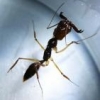Found today around 4:30 PM wandering across a sidewalk in Northeastern Kansas following a morning shower. The area was adjacent to a rather wooded creek and a well manicured field around a baseball diamond. Urban area nearby, too, so really a lot of overlap. Had several little red mites on her legs that were very annoying to move. Wondering if it was too windy and she's infertile, but going to give it a shot anyway.
She's 6mm long in that position, but could probably be 7mm if she stuck her gaster out straight. Uniformly a dull, deep redish color. Kind of obvious in the photo, but two petioles. It looks a lot more petite/less bulky in person. An artifact of the crummy photos, I suppose.
I really need to get a digital camera with a manual focus. I'm assuming it's Aphaenogaster, but can't tell if it's parasitic or not. Are there any easy ways to know for sure? I'm making very little progress with Google images.
Edited by Antsinmycloset, October 10 2016 - 8:39 PM.
















